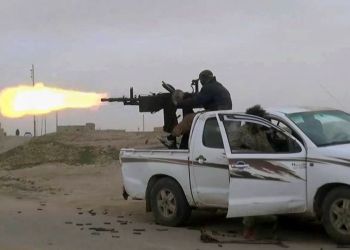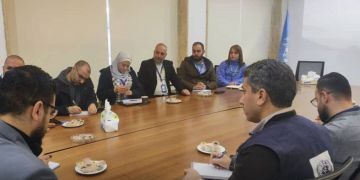This post is also available in:
![]() العربية
العربية
The Assud Sharqiyah, one of the most significant factions from Deir Ezzor province, has been involved in fierce clashes against Daesh in the Syrian Badiyah and the eastern Qalamon for several days. The ‘Sarajnah Al-Jiyahd’ (We Have Saddled Our Horses) military operation has enabled the faction to liberate, in cooperation with some factions from rural Damascus, around 150 km square of Syrian territory from the organization.
The ongoing military operations against the organization are aimed at the lifting of the siege on the eastern Qalamoun in order to link it with the liberated areas in the Syrian Badiya. However, the real goal of the Assud Sharqiyah is focused on liberation of the Syrian Badiya and the eastern Qalamon to secure supply routes for penetration operations into the northern countryside of Deir Ezzor province. The central command of the factions has made it obvious that its primary goal behind the operations is to re-enter Deir Ezzor three years after their withdrawal from it. It also wants to cut off roads to the SDF who will have more chance to move towards the province once the Raqqa campaign’s achievements are attained.
The Assud Sharqiyah has a strong support from the mass in Deir Ezzor, which will facilitate the liberation of the province in a short period. If they entered Deir Ezzor, it would trigger a local resistance from the anti-Daesh tribes and activate the sleeper cells of the factions who have long been conducting assassination operations against the organization and targeting its patrols with IEDs. This would confuse and shake the organization from the inside and reduce the effectivity of their security in the province. Assud Sharqiyah, and other local factions from Deir Ezzor, could also push many of the local factions, who have supported the organization since their arrival in the province, to fight alongside them by giving them guarantees, given the fact that the military operations of those factions have been limited to the regime-held areas.
The local factions in Deir Ezzor have more advantages than the SDF for they are fully aware of the geographical and social structures of the province, meaning that a military solution from southern Syria is possible, more productive and practical if it obtained a support from the international coalition. The coalition is not relying on them to the very moment, bearing in mind that they are fighting against Daesh in southern Syria without any logistical or areal support from it.
The southern solution is faced with a northern solution which is more complex and has a little chance to be put into practice. This is embodied in the halting of the Euphrates Shield military operations in northern Syria, of which two local factions from Deir Ezzor ( Ahrar Sharqiyah and the Deir Ezzor Military Council, which has been formed recently in northern Aleppo) were part of.
However, there is a hope that that solution would be implemented, mainly after the reports about an agreement between Turkey and USA to use factions from Raqqa, Deir Ezzor and Hasakah, who had operated under the command of Euphrates Shield, being backed by Turkish special forces to take part in the liberation of Raqqa and then Deir Ezzor in cooperation with the SDF.
This is not a new plan as Turkey had previously rejected similar plans after the launching of ‘Wrath of the Euphrates’ operation to liberate Raqqa. It does not want the SDF playing any role in the liberation of the province, making it the weakest and the most unlikely solution to execute. The practical and futile southern choice, which is not backed by the international coalition, and the complex northern solution puts the SDF in a favorable position in which they will be the selected forces to launch the operation to capture Deir Ezzor province from the organization for they are a trusted and tested US ally.
But, to rely mainly on the SDF in the battle of Deir Ezzor, will cause several difficulties, first of which is to eliminate the participation of the local faction in the battle, which would cause instability in the province if Daesh was expelled from it since the locals see the SDF as an enemy who has announced on public its alliance with the Assad regime and Russia. The SDF will also empower the propaganda of the organization which revolves around injustice being inflicted on Sunni Arabs by the alliance of the ‘forces of evil’, meaning that many families would side with it against against the SDF for some of them see Daesh presence in the province as the lesser of evil, preferring it over the regime and its allies.
The polices practiced by the SDF are counter-productive for the locals in Deir Ezzor, particularly because of the displacing of Arab civilians and carrying out massacres against them through the delivery of coordinates of their homes to the coalition in the countryside of Raqqa and Hasakah following the retreat of Daesh from those areas. The participation of some Arab factions in the SDF operation such as the Deir Ezzor Military Council and the Nukhbah Forces will not change the equation that much.
These scenarios are faced with the regime’s avidity for the capturing of the entire province from the organization. It has begun advancing towards eastern Aleppo and Palmyra in the Syrian Badiyah. It also formed a faction in Deir Ezzor made up of the locals and named ‘the Popular Mobilization” which has headquarters in Damascus and Palmyra in order to provide them with data and intelligence that would help them advance from Palymara to Shukhan from which they would advance to the Shula in north of Deir Ezzor, which would enable them to open a supply route for the regime forces who have been besieged in the regime held pocket since 2013.










